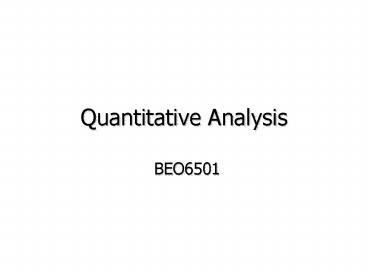Quantitative Analysis - PowerPoint PPT Presentation
1 / 25
Title:
Quantitative Analysis
Description:
... (or minimum) value of a linear function subject to a set of linear constraints. ... Producing fractional values may not make. sense in many circumstances. ... – PowerPoint PPT presentation
Number of Views:30
Avg rating:3.0/5.0
Title: Quantitative Analysis
1
Quantitative Analysis
- BEO6501
2
Themes
- These lectures will deal with applications of
binary and integer programming. - We seek ways to find the maximum (or minimum)
value of a linear function subject to a set of
linear constraints. - In the case of integer programming, some or all
of the variables must be integers (or whole
numbers). - In the case of binary programming, some or all of
the variables must be dummy variables that take
on the values 1 or 0.
3
Reference
- Refer to Lapin
- Integer and Goal Programming.
- We will focus on writing the maximizing or
minimizing models. - We will use Excel Solver to solve the optimizing
problems. - Manual calculations are exceedingly complicated
in all but the most trivial problems.
4
Integer programming
- Consider the widgets problem modified from Lapin
and Whistler. - The solution involved fractional values of the
decision variables. - The problem
- Decision variables
- Xr number of regular widgets produced
- Xd number of deluxe widgets produced
- Profit
- P 10 Xr 15 Xd
- Constraints
- 5 Xr 8 Xd ? 90 (finishing hours)
- 1 Xr 1 Xd ? 15 (frames)
- 0 Xr 1 Xd ? 3 (deluxe minimum)
- 1 Xr 0 Xd ? 9 (regular maximum)
- The relevant spreadsheet and output follows.
5
Contains 10 B9 15 B10.
Contains 5 B9 8 B10.
Contains 1 B9 1 B10.
Contains B10.
Contains B9.
6
Fill the Solver window as follows.
7
Notice that the solution involves fractional
values of the decision variables. Producing
fractional values may not make sense in many
circumstances. We could round off the values
(XD 6) but this answer could be wrong.
8
Integer constraints
- We now have to instruct Solver that the variables
must be integers. - Add the following.
9
Add extra constraints.
10
(No Transcript)
11
Notice that the solution appears as though XD
5.6 was rounded off to XD 6. Note, however,
that XR which was an integer in the earlier
solution has changed too.
12
Binary programming
- A network problem
- Least cost of travelling through a network from
start to finish.
10
A
D
4
4
Start
5
Finish
2
B
7
6
C
13
The model
- Decision variables
- Xij 1 if we travel from node I to node j, 0
otherwise. - One way out of the start
- Xsa Xsb Xsc 1.
- One way in to the finish
- Xdf Xcf 1.
- All other nodes
- If a node is entered, it must be subsequently
departed from. - If a node is not entered, it cannot be departed
from. - Ways in ways out.
- E.g. Xad Xbd Xdf or Xad Xbd - Xdf 0.
14
Contains 4B52B66B710B85B97B104B11.
Contain cell addresses of the decision variables.
Contain the right hand sides of the constraints.
Contain formulas for the left hand sides of the
constraints. In B13, B5B6B7. In B14,
B5-B8. In B15, B6-B9. In B16, B7-B10. In B17,
B8B9-B11. In B18, B10B11.
15
We have to open the constraint window a little
more to see the Binary constraint.
16
We have to open the constraint window a little
more to see the Binary constraint.
17
Minimum cost
Solution.
18
Binary programming
- Solution
- Least cost of travelling through a network from
start to finish.
10
A
D
4
4
Start
5
Finish
2
B
7
6
C
19
Assignment problem
- The problem
- The task is to assign a maximum of 6 new banking
facilities to 8 possible locations. - The expected profits differ from location to
location. - The costs vary from location to location.
- The availability of staff is limited and
different locations would require different
staffing levels. - Some groups of locations have maxima and minimum
requirements. - Decision variables
- Xi 1 if location I is selected, 0 otherwise.
20
Assignment problem (cont.)
- Profit.
- P 87X1 75X2 67X3 83X4 77X5 90X6
88X7 69X8. - Cost and budget.
- 10X1 12X2 14X3 15X4 11X5 12X6 13X7
14X8 ? 80. - Region A (locations 1 to 4).
- X1 X2 X3 X4 ? 4.
- X1 X2 X3 X4 ? 2.
- Region B (locations 5 to 8).
- X5 X6 X7 X8 ? 4.
- X5 X6 X7 X8 ? 2.
- Must locate at location 1 or 2 but not both.
- X1 X2 1.
- Maximum.
- X1 X2 X3 X4 X5 X6 X7 X8 ? 6.
21
87B475B567B683B777B8
90B988B1069B11
Contain formulas for the left hand sides of the
constraints. In B13, B4B5B6B7B8B9B10B11. I
n B14, 10B412B514B615B711B8
12B913B1014B11. In B16, B4B5B6B7. In
B17 and B18, B4B5B6B7. In B17 and B18,
B8B9B10B11. In B19, B4B5.
22
(No Transcript)
23
(No Transcript)
24
Maximum profit
Solution
25
(No Transcript)

